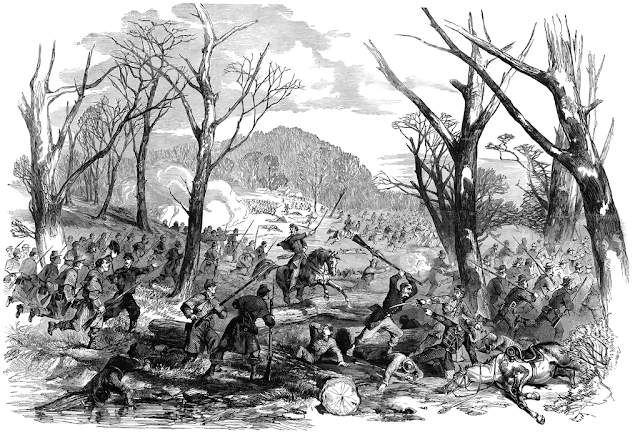A Librarian's First Battle: At Mill Springs with the 2nd Minnesota
Samuel Pearce Jennison was working as the state librarian of Minnesota in the spring of 1861 when the Civil War began. At the call to arms, he joined the 2nd Minnesota Volunteer Infantry and was commissioned as regimental adjutant reporting to Colonel Horatio P. Van Cleve. The regiment joined the Army of the Ohio in Kentucky in October 1861 and first smelled powder on January 19, 1862 at the Battle of Mill Springs.
After hurriedly being called into line that morning, the 2nd Minnesota marched to the front. "We got down about three quarters of a mile and formed in line of battle," the former librarian wrote. "While standing in that position, three cannon shots were fired over the line and struck a few rods from us. That showed the fellows were in earnest, previous to which I supposed it was only a feint to alarm us." The Minnesotans approached the line being held by the 10th Indiana and 4th Kentucky intended to relieve them, but when those two regiments fell back, they passed through the ranks of the 2nd Minnesota throwing the regiment into confusion. "Our men, many of them, got mixed up with them, and the line was thrown into momentary confusion. However, in half a minute at most, the danger was all over. Colonel Van Cleve, Colonel George, and myself all were behind that wing and assisted to stop the disaster. Then the men went at their regular work and after about 25 minutes of very hot firing the enemy had enough and retreated."
Adjutant Jennison's account of Mill Springs first saw publication in the February 7, 1862 edition of the Southbridge Journal in Massachusetts.
Camp Cumberland, near Somerset, Kentucky
January 21, 1862
A little after
reveille on Sunday morning, I was dressing in my old company tent when the
first sergeant came in saying “Captain, they are going to beat the long roll.”
I was just putting on my blouse, so I buckled on my sword, stuffed my revolver
into my belt, and was ready. The long roll was now beating and in about five
minutes the regiment was in line. The colonel mounted and commanded, “Left
face, forward, march!” As soon as my horse could be saddled, I followed, mounting
for the first time to go into battle.
We got down
about three quarters of a mile and formed in line of battle. While standing in
that position, three cannon shots were fired over the line and struck a few
rods from us. That showed the fellows were in earnest, previous to which I
supposed it was only a feint to alarm us. Our artillery replied and after a while
we were ordered forward to support the 10th Indiana and 4th
Kentucky. These regiments had been encamped nearer the enemy than we. They were
nearly out of cartridges and just as we approached them, they were ordered to
retreat or retire. At the very moment when our right wing received the first
fire, some officer of the other regiment (either the 4th Kentucky or
10th Indiana) called out to the men to retreat. Our men, many of
them, got mixed up with them, and the line was thrown into momentary confusion.
However, in half a minute at most, the danger was all over. Colonel Van Cleve,
Colonel George, and myself all were behind that wing and assisted to stop the
disaster. Then the men went at their regular work and after about 25 minutes of
very hot firing the enemy had enough and retreated.
We then put
ourselves in motion to pursue and followed them in line of battle for the
General was bound not to fall into an ambuscade. So we went through woods, over
fallen trees, low wet grounds, fences, fields, gardens, dooryards, up and down
hills and ravines for six or seven miles when it came on dark. I lay on three
rails without anything over the rails or over me and slept not a wink. In the
morning, the artillery tried to burn the steamboat lying at the landing on the
opposite side of the river, but the Rebels were all over and so burned it themselves.
We were then formed and marched into their entrenchments. They had had no time
to secure the most necessary articles, nor those light thing which one would be
likely to leave last such as miniatures, watches, knives, pistols, letters,
etc. I saw fires still smoldering in the fireplaces and took a corncake yet
warm from the pan. There was everything which you could find in any camp. There I wrote
you the former letter and there I took the commission which I now send you. I lost
my revolver and got not a cent worth; T. got a sword and a nice trunk.
You will see
the official report of the battle which I think will show you that the 2nd
Minnesota was in a good place, and it will appear that I did my duty. I certainly
tried, shunning no unnecessary exposure, and courting no needless danger. I
telegraphed you two days ago that I was entirely unhurt which was the case. We
have no orders yet to move from here and we may stay a number of days.
To learn more about the Battle of Mill Springs, check out the following links:
Nip and Tuck with the 2nd Minnesota at Mill
Springs
A Tale of Two Colonels: A Blue & Gray View of Mill
Springs
Trembling in Our Very Boots: a Hoosier Describes Mill Springs
The Odyssey of Zollicoffer’s Body
Source:
Letter from Adjutant Samuel Pearce Jennison, 2nd
Minnesota Volunteer Infantry, Southbridge Journal (Massachusetts),
February 7, 1862, pg. 2












Comments
Post a Comment